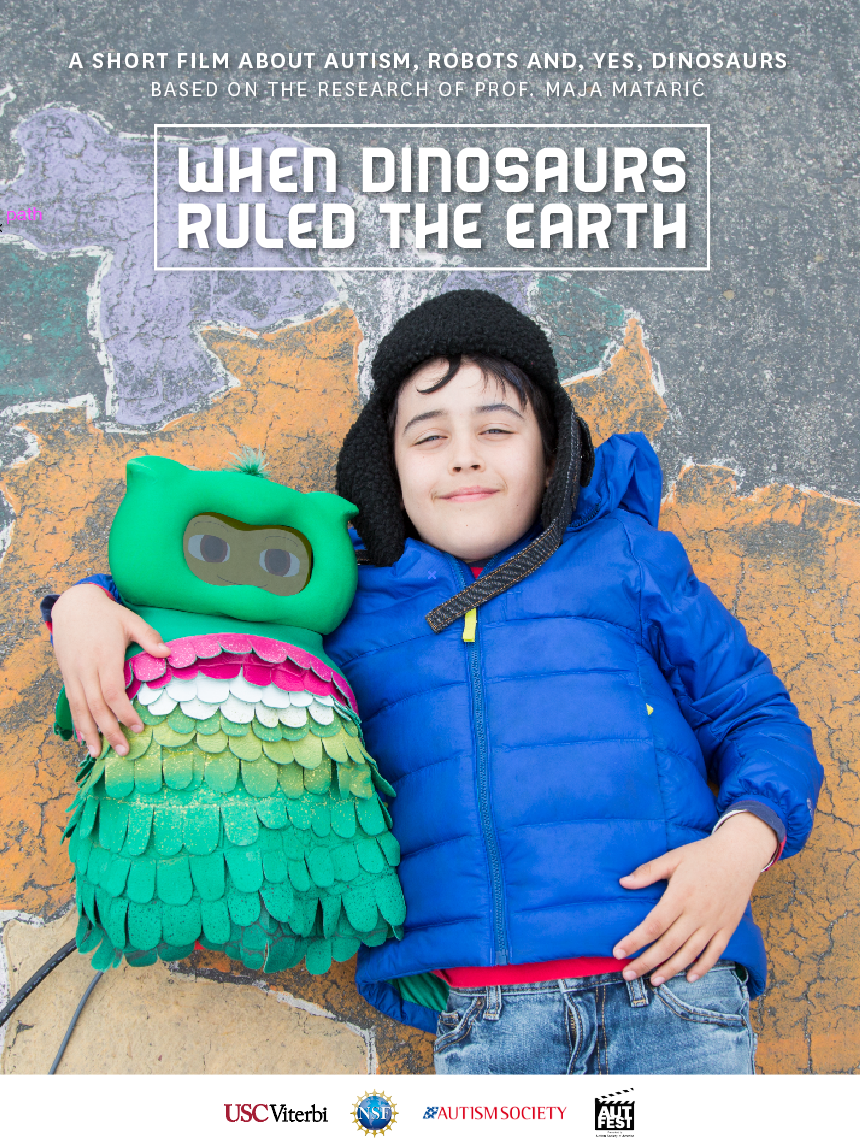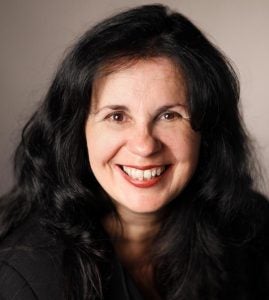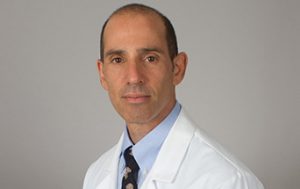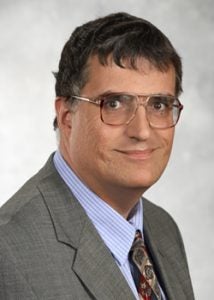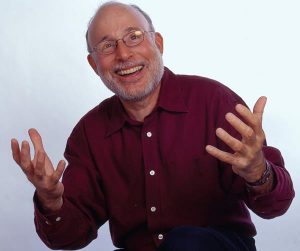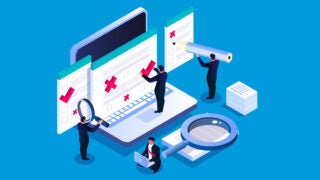Old-fashioned empathy and new tech are teaming up to improve autism awareness and research
With characters who have autism in “Sesame Street,” the new Power Rangers movie and even a new film from the USC Viterbi School of Engineering, more attention than ever is being given to the challenges posed by Autism Spectrum Disorder (ASD). As the calendar turns to April and National Autism Awareness Month, USC experts in engineering, education, medicine, business and cinema discuss the topic.
Contact: Ian Chaffee at (213) 810-8554 or ichaffee@usc.edu
The new short film When Dinosaurs Ruled the Earth, an AutFest International Film Festival 2017 selection, tells the story of a robot helping a child with autism to socialize. Please click through to play the trailer. Photo by Noe Montes.
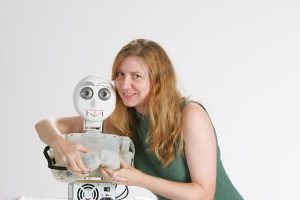 Robots creating connection
Robots creating connection
“Robots can create social bridges. Most children love robots, so if a child with autism has a cool robot, the robot will attract other children and create opportunities for social play for the child that are otherwise missing for children with autism. I hope to see these robots bring children together.
“Our goal is not to create robots that will further isolate children, but just the opposite — each robot can bring its owner together with other children, serving as a social magnet, bridge, and catalyst that creates opportunities for the child to play with others and learn social skills.”
Maja J. Matarić’s research on this topic is dramatized in the new short film, “When Dinosaurs Ruled the Earth,” an AutFest International Film Festival 2017 selection. She can discuss how robots can improve social dynamics for children with ASD.
Matarić is vice dean for research at USC Viterbi.
Contact: mataric@usc.edu or Amy Blumenthal at (917) 710-1897
Gisele Ragusa, professor of engineering education practice at USC Viterbi, has been a developmental disabilities and autism spectrum disorder (ASD) educator, specialist and researcher for over 31 years. She has conducted assessments on more than 3,000 children and adults with ASD.
Ragusa also conducts research in robotics and therapeutic interventions for children with autism and serves as the educational and developmental expert on these research teams. She has co-developed games, technology applications and associated research interventions for assisting learning in children and adults with ASD and other developmental disabilities.
Contact: ragusa@usc.edu
____________________________________________________________
“There’s overwhelming data — really, incontrovertible data — that autism is not vaccine-related and, quite frankly, the research that spurred that whole idea has now been clearly debunked as not only wrong, but fraudulent.
“People are still struggling with this idea that there are many, many paths to many disorders, and it’s not clear that the things that treat some will treat all if they’ve come to the disorder in a different way.”
Steven Siegel can discuss medical issues and adaptive strategies surrounding ASD and disorders like it. He is chair of the Department of Psychiatry and Behavioral Sciences at the Keck School of Medicine of USC.
Contact: Meg Aldrich, Keck School of Medicine of USC Marketing and Communications, at (323) 442-3941 or Meg.Aldrich@med.usc.edu
____________________________________________________________
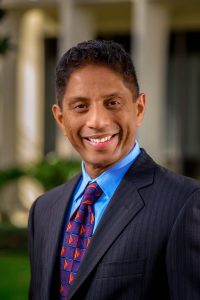 Better ways of hearing and seeing produce better treatment
Better ways of hearing and seeing produce better treatment
“We can understand autism in detail and ways that weren’t possible before. For example, knowing that someone’s speech timing is off and facial movements are rough and asymmetrical in conversation can help with further individualizing diagnosis and treatment plans for ASD.
“If technology can be a part of contributing to the health and well-being of people, especially those with cognitive and mental difficulties, what better use of engineering can there be?
“We want to further empower psychologists, both researchers and clinicians, with scientific data and engineering techniques that would further enhance their work.”
Shrikanth Narayanan can discuss his groundbreaking research in using video and sound data-capture techniques to help autism care professionals better diagnose and treat those with ASD, as well as other technologies that are helping to fight autism. He holds the Niki and C. L. Max Nikias Chair in Engineering and is director of the Signal Analysis and Interpretation Lab at USC Viterbi.
Contact: shri@sipi.usc.edu
____________________________________________________________
“Our worldwide study, ENIGMA-Autism, screens brain scans from over 30 medical centers assessing children and adults in the autism spectrum. It’s a global alliance discovering brain markers of autism that no one lab could discover on its own.
“Our research team’s key goals are to use brain scans to help diagnose children sooner and to see which interventions are helpful for which children.”
Paul Thompson is a professor of neurology at the Keck School of Medicine of USC. He leads a global alliance called ENIGMA that screens brain scans from 35 countries to discover hallmark signs of 18 different brain disorders. Thompson is also associate director of the USC Mark and Mary Stevens Neuroimaging and Informatics Institute, which is devoted to understanding the human brain using new brain-mapping technologies.
Contact: (323) 442-7246 or pthomp@usc.edu
____________________________________________________________
Lars Perner, an assistant professor of clinical marketing at the USC Marshall School of Business, was diagnosed with Asperger’s Syndrome at age 31 in 1995.
Perner lectures about the effective strategies to compensate for being on the spectrum.
He also consults businesses on the unique abilities and strengths of each individual on the spectrum, matching them with potential careers and employment.
Perner is on the board of the Autism Society of America and is the editor of Scholars With Autism Achieving Dreams, a 2012 compilation of life stories and insights of individuals on the autism spectrum who have entered into academic professions.
He has participated in task forces of the National Institute of Mental Health, as well as Centers for Disease Control and Prevention to identify the state of the current autism population and anticipated future trends.
Contact: perner@marshall.usc.edu
____________________________________________________________
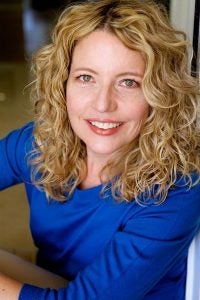 New hope for response to treatment
New hope for response to treatment
“Thanks to improved public health education on autism spectrum disorder, most parents and providers now recognize that vaccines do not cause ASD. Potential causes are many and include genetics and toxins in the environment.
“Although there are no blood tests or brain scans to confirm a diagnosis of ASD, functional magnetic resonance imaging studies show that the ASD brain displays hyperconnectivity in key brain regions involved in integrating information, external sensations and emotion, also known as ‘the salience network.’ These brain region findings show promise in the development of biomarkers for ASD and have implications for response to treatment.
“Parents should seek clinicians with experience in non-pharmacologic and pharmacologic treatment that takes into account the uniqueness of the autistic brain.”
Julie Dopheide can discuss current pharmacologic advances in treating ASD. She is professor of clinical pharmacy, psychiatry and the behavioral sciences at the USC School of Pharmacy and the Keck School of Medicine of USC.
Contact: (323) 442-1454 or dopheide@usc.edu
____________________________________________________________
“The most recent CDC estimate is that one in 68 school-aged children has been identified with ASD.
“Despite its prevalence, families still are unaware and unable to access effective evidence-based treatments. A critical need exists for more emotionally engaging, evidence-based, scientific education on understanding and treating this disorder.”
Mark Harris uses film and television media to create empathy for those with autism, as well as provide resources for families. He is a distinguished professor of film and TV at the USC School of Cinematic Arts.
Contact: (213) 740-3319 or mharris@cinema.usc.edu

